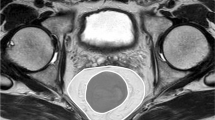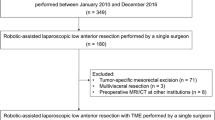Abstract
Purpose
This study was to investigate the effect of mesorectal fat tissue volume (MRV) on the pathological response to neoadjuvant chemoradiotherapy (nCRT) in patients with locally advanced rectal cancer.
Methods
88 patients who had been diagnosed with locally advanced rectal cancer between January 2017 and June 2020 were reviewed retrospectively. The total abdominal, subcutaneous, visceral, and mesorectal fatty tissue components were measured semiquantitatively by two radiologists using computed tomography (CT)-based findings. The patients were divided into two groups as those with and without a pathological response to nCRT. The relationship of MRV with the other fat tissue components of the body was also evaluated.
Results
We performed a retrospective analysis of 88 patients (mean age 62.7 years [range, 33–90 years]; 31 males and 57 females). A positive response to nCRT was present in 47 patients. There were 59 patients with stage 3 disease. 46 patients demonstrated lymph node involvement. The mean MRV was 69.6 ± 31.0 ml in no-response group and 105.8 ± 47.5 ml in response-positive patients (p < 0.05). MRV showed the highest correlation with visceral fat volume (VFV). There was a negative correlation between the MRV and the N stage. A cut-off value of ≥ 69.4 for MRV predicted the repsonse to nCRT, with 82.9% sensitivity and 58.5% specificity [AUC: 0.757 (0.653–0.842), p < 0.001] in receiver operating characteristic (ROC) curve analysis
Conclusions
MRV can be used as a novel parameter in predicting of pathological response to nCRT in locally advanced rectal cancer patients.


Similar content being viewed by others
References
Arnold M, Sierra MS, Laversanne M, Soerjomataram I, Jemal A, Bray F. Global patterns and trends in colorectal cancer incidence and mortality. Gut. 2017;66(4):683-691. doi: https://doi.org/10.1136/gutjnl-2015-310912.
Siegel RL, Kimberly D Miller KD, Jemal A. Cancer statistics, CA Cancer J Clin. 2020 Jan;70(1):7-30. doi: https://doi.org/10.3322/caac.21590
van Gijn W, Marijnen CA, Nagtegaal ID, Kranenbarg EM-K, Putter H, Wiggers T, et al. Preoperative radiotherapy combined with total mesorectal excision for resectable rectal cancer: 12-year follow-up of the multicentre, randomised controlled. Randomized Controlled Trial TME trial. 2011;12(6):575–582. doi: https://doi.org/10.1016/S1470-2045(11)70097-3
van de Velde JH Cornelis, Boelens PG, Josep MB, Jan C-W, Andres C, Lennart B, et al. EURECCA colorectal: multidisciplinary management: European consensus conference colon & rectum, Eur J Cancer. 2014; 50(1):1-34. https://doi.org/10.1016/j.ejca.2013.06.048
Monique Maas, Patty J Nelemans, Vincenzo Valentini, Prajnan Das, Claus Rödel, Li-Jen Kuo, et al. Long-term outcome in patients with a pathological complete response after chemoradiation for rectal cancer: a pooled analysis of individual patient data. Lancet Oncol. 2010; 11(9):835–844. doi: https://doi.org/10.1016/S1470-2045(10)70172-8
Påhlman L, Bohe M, Cedermark B, Dahlberg M, Lindmark G, Sjödahl R, et al. The Swedish rectal cancer registry. Br J Surg. 2007; 94(10):1285-1292. doi: https://doi.org/10.1002/bjs.5679.
Patel UB, Taylor F, Blomqvist L, George C, Evans H, Tekkis P, et al. Magnetic resonance imaging–detected tumor response for locally advanced rectal cancer predicts survival outcomes: MERCURY experience. J Clin Oncol. 2011; 29(28):3753-3760. doi: https://doi.org/10.1200/JCO.2011.34.9068
Patel UD, Brown G, Rutten H, West N, Sebag-Montefiore D, Glynne-Jones R,et al. Comparison of magnetic resonance imaging and histopathological response to chemoradiotherapy in locally advanced rectal cancer. Ann Surg Oncol. 2012; 19(9):2842-2852. doi: https://doi.org/10.1200/JCO.2011.34.9068
Hötker AM, Tarlinton L, Mazaheri Y, Woo KM, Gönen M, Saltz LB, et al. Multiparametric MRI in the assessment of response of rectal cancer to neoadjuvant chemoradiotherapy: A comparison of morphological, volumetric and functional, MRI parameters. Eur Radiol. 2016; 26(12):4303-4312. doi: https://doi.org/10.1007/s00330-016-4283-9
Kim SH, Chang HJ, Kim DY, Park JW, Baek JY, Kim SY, et al., What Is the Ideal Tumor Regression Grading System in Rectal Cancer Patients after Preoperative Chemoradiotherapy?, Cancer Res Treat. 2016 Jul; 48(3): 998–1009.
Santos MD, Silva C, Rocha A, Matos E, Nogueira C, Lopes C. Prognostic Value of Mandard and Dworak Tumor Regression Grading in Rectal Cancer: Study of a Single Tertiary Center, ISRN Surg. 2014 Mar 4;2014:310542. doi: https://doi.org/10.1155/2014/310542
Cui Y, Yang X, Shi Z, Yang Z, Du X, Zhao Z, et al. Radiomics analysis of multiparametric MRI for prediction of pathological complete response to neoadjuvant chemoradiotherapy in locally advanced rectal cancer. Eur Radiol. 2019; 29(3):1211-1220. doi: https://doi.org/10.1007/s00330-018-5683-9
Yi X, Pei Q, Zhang Y, Zhu H, Wang Z, Chen C, et al. MRI-based radiomics predicts tumor response to neoadjuvant chemoradiotherapy in locally advanced rectal cancer. Front Oncol. 2019;26;9:552-562 https://doi.org/10.3389/fonc.2019.00552
Shu Z, Fang S, Ye Q, Mao D, Cao H, Pang P, et al. Prediction of efficacy of neoadjuvant chemoradiotherapy for rectal cancer: the value of texture analysis of magnetic resonance images, Abdom Radiol. 2019; 44(11):3775-3784. doi: https://doi.org/10.1007/s00261-019-01971-y
Ryan JE, Warrier SK, Lynch AC, Herio AG. Assessing pathological complete response to neoadjuvant chemoradiotherapy in locally advanced rectal cancer: a systematic review. Colorectal Dis. 2015; 17(10):849-861. https://doi.org/10.1111/codi.13081
Kidron D, Lahav L, Berkovich L, Mishaeli M, Haj N, Shmuel Y. Lack of Pathological Response of Rectal Cancer to Neoadjuvant Chemoradiotherapy is Associated with Poorer Long-Term Oncological Outcomes. Clinical Oncology and Research 2019; 2(5):1-6. doi: https://doi.org/10.31487/j.COR.2019.5.18
Akay S, Urkan M, Balyemez U, Erşen M, Taşar MJD. Is visceral obesity associated with colorectal cancer? The first volumetric study using all CT slices. Diagn Interv Radiol. 2019; 25(5):338-345. doi: https://doi.org/10.5152/dir.2019.18350.
Garland ML, Vather R, Bunkley N, Pearse M, Bissett IP. Clinical tumour size and nodal status predict pathologic complete response following neoadjuvant chemoradiotherapy for rectal cancer. Int J Colorectal Dis 2014; 29: 301–7.
Qiu HZ, Wu B, Xiao Y, Lin GL. Combination of differentiation and T stage can predict unresponsiveness to neoadjuvant therapy for rectal cancer. Colorectal Dis 2011; 13: 1353–60.
Huh JW, Kim HR, Kim YJ. Clinical prediction of pathological complete response after preoperative chemoradiotherapy for rectal cancer. Dis Colon Rectum 2013; 56: 698–703.
Gollub MJ, Tong T, Weiser M, Zheng J, Gonen M, Zakian KL. Limited accuracy of DCE-MRI in identification of pathological complete responders after chemoradiotherapy treatment for rectal cancer. Eur Radiol. 2017;27(4):1605-1612. doi: https://doi.org/10.1007/s00330-016-4493-1
Sassen NS, M de Booij, Sosef M, Berendsen R, Lammering G, Clarijs R, et al. Locally advanced rectal cancer: is diffusion weighted MRI helpful for the identification of complete responders (ypT0N0) after neoadjuvant chemoradiation therapy? Eur Radiol . 2013 Dec;23(12):3440–9. doi: https://doi.org/10.1007/s00330-013-2956-1
Jung SH, Heo SH, Kim JW, Jeong YY, Shin SS, Soung MG, et al. Predicting response to neoadjuvant chemoradiation therapy in locally advanced rectal cancer: Diffusion‐weighted 3 tesla MR imaging J Magn Reson Imaging. 2012 Jan;35(1):110–6. doi: https://doi.org/10.1002/jmri.22749.
Clark W, Siegel EM, Chen YA, Zhao X, Parsons CM, Jonathan M, et al. Quantitative measures of visceral adiposity and body mass index in predicting rectal cancer outcomes after neoadjuvant chemoradiation. J Am Coll Surg. 2013; 216(6):1070-1081 https://doi.org/10.1016/j.jamcollsurg.2013.01.007
Yoon J, Chung YE, Lim JS, Kim M-J. Quantitative assessment of mesorectal fat: New prognostic biomarker in patients with mid-to-lower rectal cancer. Eur Radiol. 2019; 29(3):1240-1247. doi: https://doi.org/10.1007/s00330-018-5723-5
Allen S, Gada V, Blunt DM. Variation of mesorectal volume with abdominal fat volume in patients with rectal carcinoma: assessment with MRI. BrJ Radiol 2007; 80(952):242-247. doi: https://doi.org/10.1259/bjr/66311683
Lee KH, Kang B-K, Ahn BKJ. Higher visceral fat area/subcutaneous fat area ratio measured by computed tomography is associated with recurrence and poor survival in patients with mid and low rectal cancers. Int J Colorectal Dis. 2018; 33(9):1303-1307. doi: https://doi.org/10.1007/s00384-018-3065-z
Torkzad MR, Hansson KA, Lindholm J, Martling A, Blomqvist L. Significance of mesorectal volume in staging of rectal cancer with magnetic resonance imaging and the assessment of involvement of the mesorectal fascia. Eur Radiol . 2007; 17(7):1694-1699 doi: https://doi.org/10.1007/s00330-006-0521-x
Sprenger T, Rothe H, Becker H, Beissbarth T, Homayounfar K, Gauss K, et al. Lymph node metastases in rectal cancer after preoperative radiochemotherapy: impact of intramesorectal distribution and residual micrometastatic involvement. Am J Surg Pathol. 2013; 37(8):1283-1299doi: 0.1097/PAS.0b013b3182886ced
Boyle KM, Chalmers AG, Finan PJ, Sagar PM, Burke D. Morphology of the mesorectum in patients with primary rectal cancer. Dis Colon Rectum. 2009; 52(6):1122-1129. doi:https://doi.org/10.1007/DCR.0b013e31819ef62f.
García-Aguilar J, Hernandez de Anda E, Sirivongs P, Lee SH, Madoff RD, Rothenberger DA. A pathologic complete response to preoperative chemoradiation is associated with lower local recurrence and improved survival in rectal cancer patients treated by mesorectal excision. Dis Colon Rectum. 2003; 46(3):298–304. doi: https://doi.org/10.1007/s10350-004-6545-x
Author information
Authors and Affiliations
Corresponding author
Additional information
Publisher's Note
Springer Nature remains neutral with regard to jurisdictional claims in published maps and institutional affiliations.
Rights and permissions
About this article
Cite this article
Dilek, O., Akkaya, H., Parlatan, C. et al. Can the mesorectal fat tissue volume be used as a predictive factor in foreseeing the response to neoadjuvant chemoradiotherapy in rectum cancer? A CT-based preliminary study. Abdom Radiol 46, 2415–2422 (2021). https://doi.org/10.1007/s00261-021-02951-x
Received:
Revised:
Accepted:
Published:
Issue Date:
DOI: https://doi.org/10.1007/s00261-021-02951-x




